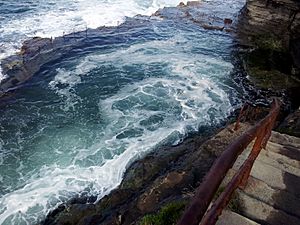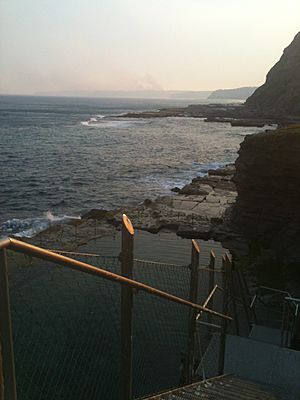Bogey Hole facts for kids
Quick facts for kids Bogey Hole |
|
|---|---|

The Bogey Hole in 2011
|
|
| Location | Shortland Esplande, Newcastle, City of Newcastle, New South Wales, Australia |
| Built | 1819–1884 |
| Owner | Newcastle City Council |
| Official name: Bogey Hole, The; The Bogey Hole; Commandant's Baths; Bogie Hole | |
| Type | state heritage (landscape) |
| Designated | 21 November 2003 |
| Reference no. | 1678 |
| Type | Swimming Pool - tidal |
| Category | Urban Area |
| Builders | Convict labour, 1819/20; enlarged to present dimensions by Newcastle Borough Council, in 1884 |
| Lua error in Module:Location_map at line 420: attempt to index field 'wikibase' (a nil value). | |
The Bogey Hole, also known as the Commandant's Baths, is a historic ocean pool in Newcastle, Australia. It's believed to be the oldest European-built structure still standing in the city. This unique pool was carved out of a rocky shelf at the base of cliffs near Shepherds Hill.
Lieutenant-Colonel James Thomas Morisset, who was in charge of Newcastle from 1818 to 1823, ordered its creation around 1820. He had convicts (people forced to work as punishment) build it for his own personal use.
The name "Bogie" or "Bogey" is thought to come from the Dharawal language, an Aboriginal language. It means "to bathe" or "a place to bathe." The Bogey Hole was added to the New South Wales State Heritage Register on 21 November 2003, recognizing its special historical importance.
Contents
Discovering the Bogey Hole's Past
The Bogey Hole is located under a cliff and often gets hit by big waves. It's only about 1.5 meters deep. Some brave locals enjoy climbing the cliff and jumping into the pool. Another exciting activity is to hold onto the chains on the ocean side when a wave washes over you.
The Bogey Hole was built for Commandant Morisset around 1820. We don't know the exact date it started or how long it took to build. Morisset was the longest-serving Commandant of Newcastle. The pool was first known as the "Commandant's Baths." The name "Bogey Hole" came later.
How the Bogey Hole Changed Over Time
The Bogey Hole sits at the bottom of Shepherds Hill. The rocks here are a mix of sandstone and conglomerate, common along the coast where Newcastle was built. These rocks are quite hard.
In 1863, the Newcastle Borough Council took over the baths for public use. The council made the pool much bigger. At first, it was mainly for male swimmers, with women allowed only at certain times. Over the years, changing sheds and other facilities were built and later removed.
The biggest changes happened in 1884. The pool was made about seven times larger and deeper. An iron safety rail was added along the path to the pool. Two bridges, stairs, and ledges were also cut into the rock face. These improvements were done by the Newcastle City Council.
In 1893, new dressing sheds and showers were built. Water for the showers came from a natural spring nearby. Even with these improvements, some people didn't think the Bogey Hole was a safe or proper place to swim.
Since then, there have been only small changes to the area around the baths. These include building a caretaker's cottage and a brick changing shed in 1953, which have since been removed.
Recent Closures and Reopenings
The Bogey Hole is still a very popular spot, especially on warm summer days. It's a favorite for people who don't like getting sand in their shoes at the beach.
In September 2003, the Bogey Hole was temporarily closed. Large rocks had fallen from the cliff into the pool, damaging fences and making the cliff unstable. It reopened in 2004 after the cliff was made safe again.
The New South Wales government now manages the baths. In 2012, they worked to improve access with a new platform and stairs. The Bogey Hole closed again in 2014 due to damage from heavy waves. It reopened in 2016 after a big project to secure the rocks, costing $490,000.
A Special Tradition at the Bogey Hole
Since the 1950s, local Greek Orthodox Churches have used the Bogey Hole for a special event called the Blessing of the Waters. On the first Sunday after the Greek Epiphany, church members pray for the safety of all people who work at sea. A priest blesses the water from the cliff. Then, young people jump into the water to try and find a metallic cross that has been placed in the Bogey Hole.
What the Bogey Hole Looks Like
The Bogey Hole is a public swimming area carved out of rock. It's located on a flat rock platform below the cliffs at Shepherd Hill. The pool is about 10 meters long and 6.5 meters wide at its widest points. Its average depth is about 1.5 meters.
In 2003, it was reported to be in good condition. It still looks much like it did after the 1884 changes.
Over time, various wooden sheds and a brick toilet block were added, but they have all been removed. The side of the pool facing the ocean has a fence with posts and chains, but we don't know when it was put there.
The Bogey Hole is now part of a public walking path called "Bathers' Way." There are plans to add a special piece of art in the picnic area above the pool, looking down at it.
Why the Bogey Hole is Important
The Bogey Hole is one of the oldest European-built structures in Newcastle. It's special because it was built by convicts for Major James Morisset, an important military leader from early Australian settlement. It is also the first known purpose-built ocean pool on the coast of New South Wales.
It's a beautiful and interesting part of the coastal landscape near King Edward Park. It also holds great social meaning for the people of Newcastle.
The Bogey Hole was listed on the New South Wales State Heritage Register on 21 November 2003 because:
- It shows important parts of New South Wales history. It's a rare example of a convict-built bath from the early 1800s.
- It's connected to important people and groups. It's linked to Commandant James Morisset and the early use of convict labor.
- It has special beauty and design. The Bogey Hole and its natural surroundings are unique and beautiful. It's a popular subject for artists and photographers. The pool itself shows early convict craftsmanship and later changes.
- It has strong social meaning for the community. It reminds us of the early days of military leaders and convict workers. In the 1850s, men and women swam on different days here. Today, it's a well-known landmark, especially for those who enjoy daring jumps into the water.
- It can teach us more about history. The Bogey Hole can help us understand early convict building methods and later changes made by the Council.
- It is a rare historical site. It's one of the earliest known swimming places built in New South Wales.
- It shows key features of similar places. The rocks are typical of the area. It's also an early example of a swimming spot built for specific groups of people.
Images for kids




